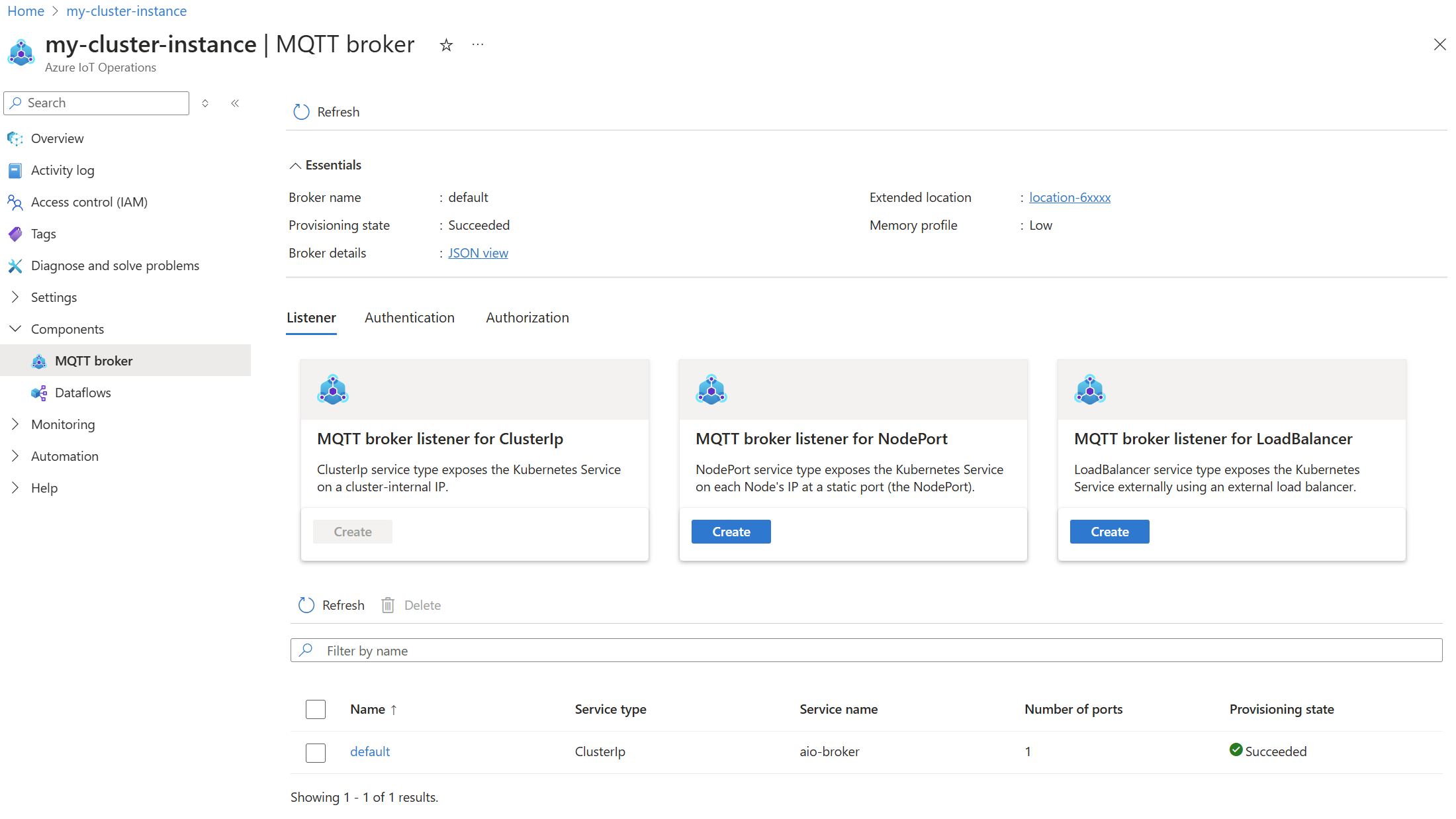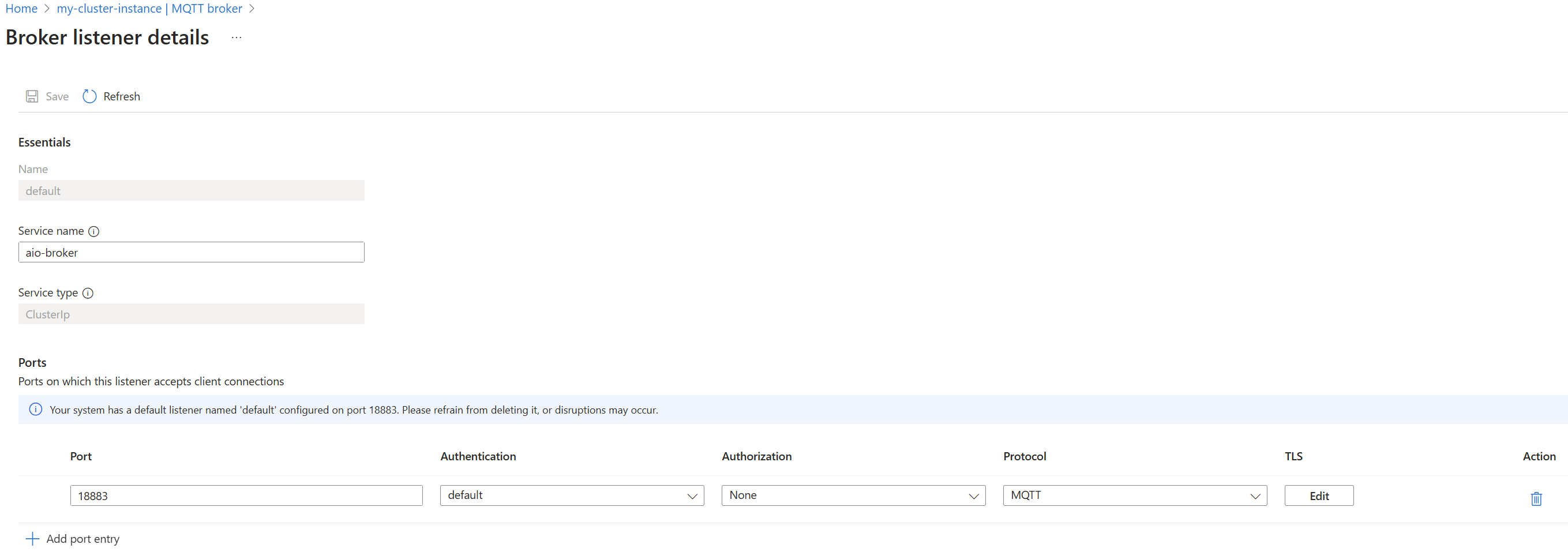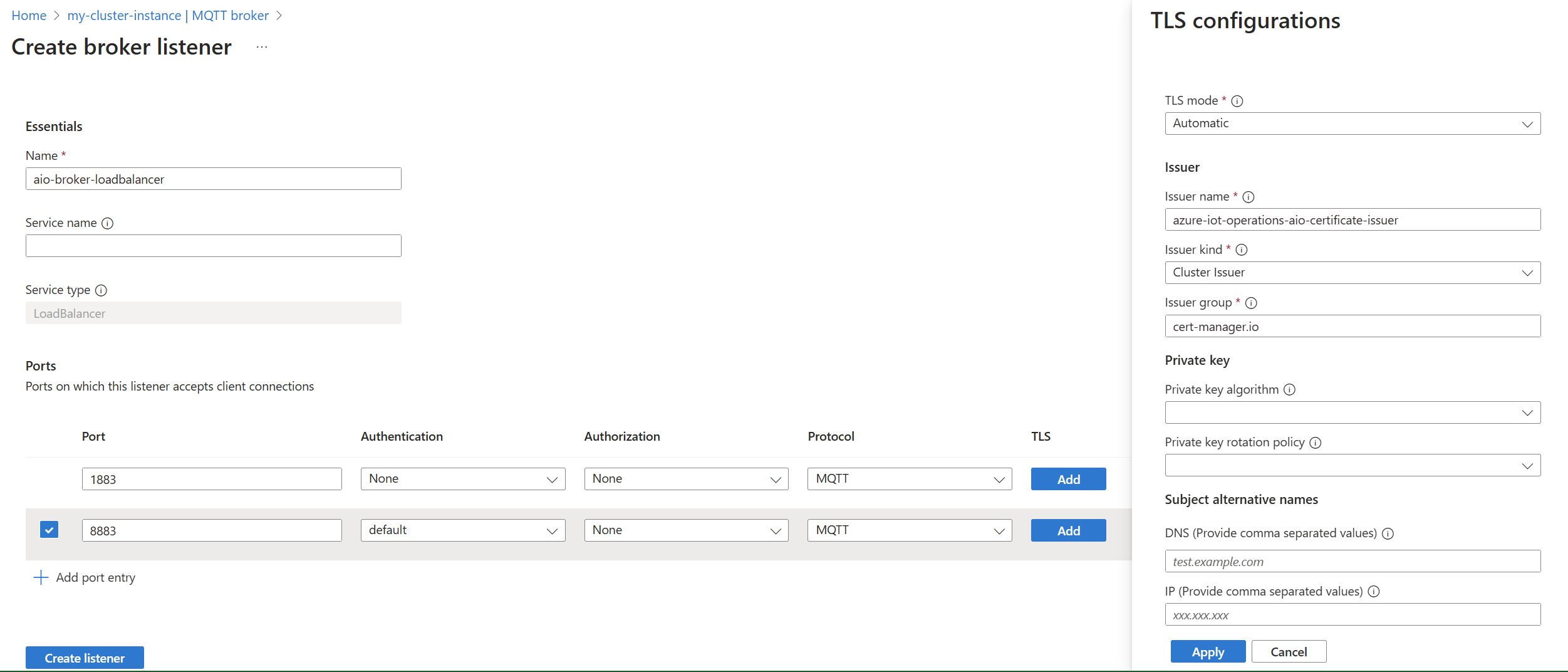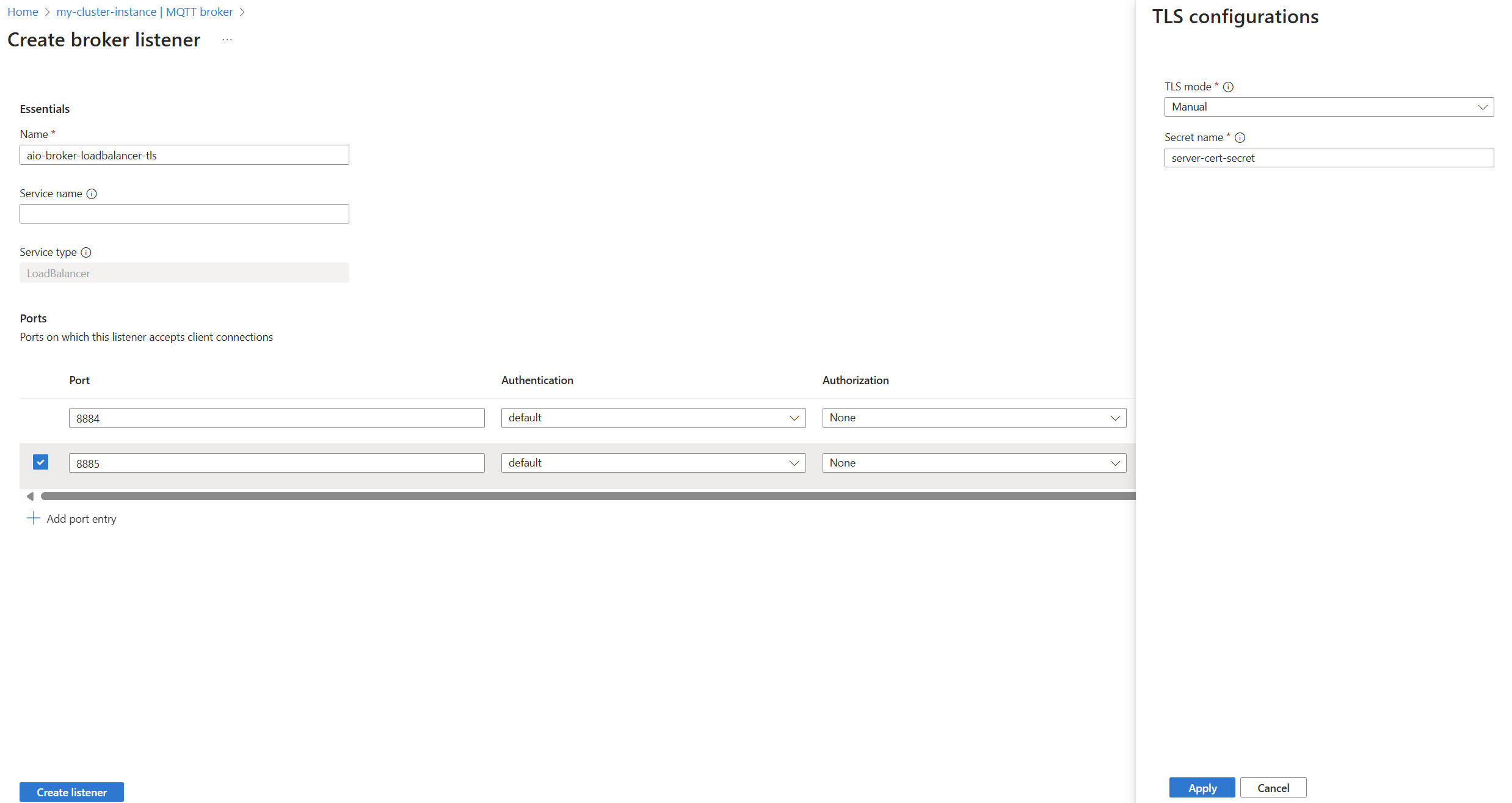Secure MQTT broker communication by using BrokerListener
Important
This page includes instructions for managing Azure IoT Operations components using Kubernetes deployment manifests, which is in preview. This feature is provided with several limitations, and shouldn't be used for production workloads.
See the Supplemental Terms of Use for Microsoft Azure Previews for legal terms that apply to Azure features that are in beta, preview, or otherwise not yet released into general availability.
A BrokerListener resource corresponds to a network endpoint that exposes the broker to clients over the network. You can have one or more BrokerListener resources for each broker, with multiple ports and different access control on each.
Each BrokerListener port can have its own authentication and authorization rules that define who can connect on that listener port and what actions they can perform on the broker. You can use BrokerAuthentication and BrokerAuthorization resources to specify the access control policies for each listener port. This flexibility allows you to fine-tune the permissions and roles for your MQTT clients based on their needs and use cases.
Tip
The default MQTT broker deployment is a cluster IP service that requires clients to connect with the Transport Layer Security (TLS) protocol and authenticate with service account tokens. Clients connecting from outside the cluster need extra configuration before they can connect.
Broker listeners have the following characteristics:
- Name: Name of the listener. This name is also the Kubernetes service name unless overridden.
- Service type: You can have up to three listeners, one per service type. The default listener is service type
ClusterIp. - Ports: Each listener supports multiple ports. Ports can't conflict over different listeners.
- Authentication and Authorization references: BrokerAuthentication and BrokerAuthorization are configured per port.
- TLS: Manual or automatic TLS configuration is applied per port.
- Protocol: MQTT over WebSockets can be enabled per port.
For a list of all available settings, see the Broker Listener API reference.
Default BrokerListener
When you deploy Azure IoT Operations, the deployment creates a BrokerListener resource named default. This listener is used for encrypted internal communication between IoT Operations components. The default listener is part of the default broker.
- It exposes a ClusterIp service on port 18883.
- It requires clients to use Kubernetes service account authentication.
- It has an automatically managed TLS certificate.
- It doesn't configure any client authorization policies.
Caution
To avoid disrupting internal IoT Operations communication, keep the default listener unchanged and dedicated for internal use. For external communication, create a new listener. If you need to use the ClusterIp service, add more ports to the default listener without changing any of the existing settings.
To view or edit the default listener, follow these steps.
In the Azure portal, go to your IoT Operations instance.
Under Components, select MQTT Broker.

From the broker listener list, select the default listener.

Review the listener settings, but avoid modifying any of the existing settings. Instead, create a new port and configure it as needed.
Avoid modifying default broker listener
To prevent disrupting internal IoT Operations communication, keep the default listener unchanged and dedicated for internal use. For external communication, create a new listener.
Since the default broker listener uses the service type ClusterIp, and you can have only one listener per service type, add more ports to the default listener without changing any of the existing settings if you need to use the ClusterIp service.
Create new broker listeners
To create a new listener, specify the following settings:
- Name: Name of the listener. This name is also the Kubernetes service name unless overridden.
- Service type: Type of the Kubernetes service. See Service type.
- Ports: List of ports to listen on. See Ports.
- Service name (optional): Override the Kubernetes service name. See Service name.
Example: Create a new listener with two ports
This example shows how to create a new listener with the LoadBalancer service type. The BrokerListener resource defines two ports that accept MQTT connections from clients.
- The first port listens on port 1883 without TLS and authentication. This setup is suitable for testing only. Don't use this configuration in production.
- The second port listens on port 8883 with TLS and authentication enabled. Only authenticated clients with a Kubernetes service account token can connect. TLS is set to automatic mode, using cert-manager to manage the server certificate from the default issuer. This setup is closer to a production configuration.
In the Azure portal, go to your IoT Operations instance.
Under Components, select MQTT Broker.
Select MQTT broker listener for LoadBalancer > Create.
Enter the following settings:
Setting Description Name Name of the BrokerListener resource. Service name Name of the Kubernetes service. Leave empty to use the listener name as service name. Service type LoadBalancer already selected. Under Ports, enter the following settings for the first port:
Setting Description Port Enter 1883. Authentication Choose None. Authorization Choose None. Protocol Choose MQTT. TLS Don't add. Select Add port entry to add a second port and enter the following settings:
Setting Description Port Enter 8883. Authentication Choose default. Authorization Choose None. Protocol Choose MQTT. TLS Select Add. On the TLS configuration pane, enter the following settings:
Setting Description TLS mode Choose Automatic. Issuer name Enter azure-iot-operations-aio-certificate-issuer.Issuer kind Choose ClusterIssuer. Leave other settings as default, and select Apply.
Select Create listener.

Service type
Each BrokerListener resource maps to a Kubernetes service. The service type determines how the broker is exposed to the network. The supported service types are:
- ClusterIp: Exposes the broker on a cluster-internal IP. Clients can connect to the broker from within the cluster. This default service type is for the default listener.
- NodePort: Exposes the broker on each node's IP at a static port. Clients can connect to the broker from outside the cluster. This service type is useful for development and testing.
- LoadBalancer: Exposes the broker externally. The service is assigned an external IP address that clients can use to connect to the broker. This service type is the most common for production deployments.
Only one listener per service type
Only one listener per service type is allowed. If you need more connectivity of the same service type, add more ports to the existing listener of that service type.
Service name
The service name is the name of the Kubernetes service associated with the broker. If not specified, the broker listener name is used as the service name. The service name must be unique within the namespace.
Tip
To prevent management overhead, we recommend that you leave the service name empty. The listener name is unique, and you can use it to identify the service. Use the service name as an override only when you can't name the service after the listener.
Ports
Each listener can have multiple ports, and each port can have its own settings for authentication, authorization, protocol, and TLS.
To use your own authentication or authorization setting for a port, you must create the corresponding resources before you use it with a listener. For more information, see Configure MQTT broker authentication and Configure MQTT broker authorization.
To use TLS, see the Configure TLS with automatic certificate management or Configure TLS with manual certificate management sections.
Use the same port across listeners
Using the same port number across different listeners isn't supported. Each port number must be unique within the IoT Operations MQTT broker.
For example, if you have a listener using port 1883, you can't create another listener with port 1883. Similarly, the default listener uses port 18883, so you can't create another listener with port 18883.
WebSockets support
IoT Operations MQTT broker supports MQTT over WebSockets. To enable WebSockets, set the protocol to WebSockets for the port.
Configure TLS with automatic certificate management
To enable TLS with automatic certificate management, specify the TLS settings on a listener port.
Verify cert-manager installation
With automatic certificate management, you use cert-manager to manage the TLS server certificate. By default, cert-manager is installed alongside IoT Operations in the cert-manager namespace already. Verify the installation before you proceed.
Use kubectl to check for the pods that match the cert-manager app labels.
kubectl get pods --namespace cert-manager -l 'app in (cert-manager,cainjector,webhook)'NAME READY STATUS RESTARTS AGE aio-cert-manager-64f9548744-5fwdd 1/1 Running 4 (145m ago) 4d20h aio-cert-manager-cainjector-6c7c546578-p6vgv 1/1 Running 4 (145m ago) 4d20h aio-cert-manager-webhook-7f676965dd-8xs28 1/1 Running 4 (145m ago) 4d20hIf you see the pods shown as ready and running, cert-manager is installed and ready to use.
Tip
To further verify the installation, check the cert-manager documentation to verify installation. Remember to use the cert-manager namespace.
Create an issuer for the TLS server certificate
The cert-manager issuer resource defines how certificates are automatically issued. Cert-manager supports several issuers types natively. It also supports an external issuer type for extending functionality beyond the natively supported issuers. You can use an MQTT broker with any type of cert-manager issuer.
Important
During initial deployment, IoT Operations is installed with a default issuer for TLS server certificates. You can use this issuer for development and testing. For more information, see Default root Certificate Authority (CA) and issuer with Azure IoT Operations. The following steps are required only if you want to use a different issuer.
The approach to create the issuer is different depending on your scenario. The following sections list examples to help you get started.
The CA issuer is useful for development and testing. It must be configured with a certificate and private key stored in a Kubernetes secret.
Set up the root certificate as a Kubernetes secret
If you have an existing CA certificate, create a Kubernetes secret with the CA certificate and CA private key PEM files. Run the following command to import the CA certificate as a Kubernetes secret and skip the next section.
kubectl create secret tls test-ca --cert tls.crt --key tls.key -n azure-iot-operations
If you don't have a CA certificate, cert-manager can generate a CA certificate for you. Using cert-manager to generate a CA certificate is known as bootstrapping a CA issuer with a self-signed certificate.
Start by creating
ca.yaml:apiVersion: cert-manager.io/v1 kind: Issuer metadata: name: selfsigned-ca-issuer namespace: azure-iot-operations spec: selfSigned: {} --- apiVersion: cert-manager.io/v1 kind: Certificate metadata: name: selfsigned-ca-cert namespace: azure-iot-operations spec: isCA: true commonName: test-ca secretName: test-ca issuerRef: # Must match Issuer name above name: selfsigned-ca-issuer # Must match Issuer kind above kind: Issuer group: cert-manager.io # Override default private key config to use an EC key privateKey: rotationPolicy: Always algorithm: ECDSA size: 256Create the self-signed CA certificate with the following command:
kubectl apply -f ca.yaml
Cert-manager creates a CA certificate by using its defaults. You can change the properties of this certificate by modifying the Certificate specification. For a list of valid options, see cert-manager documentation.
Distribute the root certificate
The prior example stores the CA certificate in a Kubernetes secret called test-ca. You can retrieve the certificate in PEM format from the secret and store it in the file ca.crt with the following command:
kubectl get secret test-ca -n azure-iot-operations -o json | jq -r '.data["tls.crt"]' | base64 -d > ca.crt
This certificate must be distributed and trusted by all clients. For example, use the --cafile flag for a Mosquitto client.
Create issuer based on CA certificate
Cert-manager needs an issuer based on the CA certificate generated or imported in the earlier step. Create the following file as issuer-ca.yaml:
apiVersion: cert-manager.io/v1
kind: Issuer
metadata:
name: my-issuer
namespace: azure-iot-operations
spec:
ca:
# Must match secretName of generated or imported CA cert
secretName: test-ca
Create the issuer with the following command:
kubectl apply -f issuer-ca.yaml
The prior command creates an issuer for issuing TLS server certificates. Note the name and kind of the issuer. In the example, the name is my-issuer and the kind is Issuer. These values are set in the BrokerListener resource later.
Enable TLS automatic certificate management for a port
The following example is a BrokerListener resource that enables TLS on port 8884 with automatic certificate management.
In the Azure portal, go to your IoT Operations instance.
Under Components, select MQTT Broker.
Select or create a listener. You can create only one listener per service type. If you already have a listener of the same service type, you can add more ports to the existing listener.
You can add TLS settings to the listener by selecting TLS on an existing port or by adding a new port.
Enter the following settings:
Setting Description Name Name of the BrokerListener resource. Enter aio-broker-loadbalancer-tls.Port Port number on which the BrokerListener listens for MQTT connections. Enter 8884. Authentication The authentication resource reference. Authorization The authorization resource reference. TLS Select the Add button. Issuer name Name of the cert-manager issuer. Required. Issuer kind Kind of the cert-manager issuer. Required. Issuer group Group of the cert-manager issuer. Required. Private key algorithm Algorithm for the private key. Private key rotation policy Policy for rotating the private key. DNS names DNS subject alternate names for the certificate. IP addresses IP addresses of the subject alternate names for the certificate. Secret name Kubernetes secret containing an X.509 client certificate. Duration Total lifetime of the TLS server certificate defaults to 90 days. Renew before When to begin renewing the certificate. Select Apply to save the TLS settings.
After the BrokerListener resource is configured, the MQTT broker automatically creates a new service with the specified port and TLS enabled.
Optional: Configure server certificate parameters
The only required parameters are Issuer name and Issuer kind. All other properties of the generated TLS server certificates are automatically chosen. However, the MQTT broker allows certain properties to be customized following the same syntax as cert-manager certificates. For example, you can specify the private key algorithm and rotation policy. These settings are under tls.certManagerCertificateSpec or on the TLS configuration pane in the Azure portal.
For a full list of these settings, see Broker Listener CertManagerCertificateSpec API reference.
Verify deployment
Use kubectl to check that the service associated with the BrokerListener resource is running. From the preceding example, the service name is aio-broker-loadbalancer-tls and the namespace is azure-iot-operations. The following command checks the service status:
$ kubectl get service my-new-tls-listener -n azure-iot-operations
NAME TYPE CLUSTER-IP EXTERNAL-IP PORT(S) AGE
aio-broker-loadbalancer-tls LoadBalancer 10.X.X.X 172.X.X.X 8884:32457/TCP 33s
Connect to the broker with TLS
After the server certificate is configured, TLS is enabled. To test with Mosquitto:
mosquitto_pub -h $HOST -p 8884 -V mqttv5 -i "test" -t "test" -m "test" --cafile ca.crt
The --cafile argument enables TLS on the Mosquitto client and specifies that the client should trust all server certificates issued by the specific file. You must specify a file that contains the issuer of the configured TLS server certificate.
Replace $HOST with the appropriate host:
- If you're connecting from within the same cluster, replace with the service name given (
my-new-tls-listenerin example) or the serviceCLUSTER-IP. - If you're connecting from outside the cluster, use the service
EXTERNAL-IP.
Remember to specify authentication methods if needed.
Default root CA and issuer
To help you get started, IoT Operations is deployed with a default "quickstart" CA certificate and issuer for TLS server certificates. You can use this issuer for development and testing. For more information, see Default root CA and issuer for TLS server certificates.
For production, you must configure a CA issuer with a certificate from a trusted CA, as described in the previous sections.
Configure TLS with manual certificate management
To manually configure an MQTT broker to use a specific TLS certificate, specify it in a BrokerListener resource with a reference to a Kubernetes secret and deploy it using kubectl. This article shows an example that configures TLS with self-signed certificates for testing.
Create a certificate authority with Step CLI
Step is a certificate manager that can quickly get you up and running when you create and manage your own private CA.
Install Step CLI and create a root CA certificate and key.
step certificate create --profile root-ca "Example Root CA" root_ca.crt root_ca.keyCreate an intermediate CA certificate and key signed by the root CA.
step certificate create --profile intermediate-ca "Example Intermediate CA" intermediate_ca.crt intermediate_ca.key \ --ca root_ca.crt --ca-key root_ca.key
Create a server certificate
Use Step CLI to create a server certificate from the intermediate CA certificate and key.
step certificate create mqtts-endpoint mqtts-endpoint.crt mqtts-endpoint.key \
--profile leaf \
--not-after 8760h \
--san mqtts-endpoint \
--san localhost \
--ca intermediate_ca.crt --ca-key intermediate_ca.key \
--no-password --insecure
Here, mqtts-endpoint and localhost are the Subject Alternative Names (SANs) for the MQTT broker's frontend in Kubernetes and local clients, respectively. To connect over the internet, add a --san with an external IP. The --no-password --insecure flags are used for testing to skip password prompts and disable password protection for the private key because it's stored in a Kubernetes secret. For production, use a password and store the private key in a secure location like Azure Key Vault.
Certificate key algorithm requirements
Both EC and RSA keys are supported, but all certificates in the chain must use the same key algorithm. If you import your own CA certificates, ensure that the server certificate uses the same key algorithm as the CAs.
Import server certificate chain as a Kubernetes secret
Create a full server certificate chain, where the order of the certificates matters. The server certificate is the first one in the file, and the intermediate is the second.
cat mqtts-endpoint.crt intermediate_ca.crt > server_chain.crtCreate a Kubernetes secret with the server certificate chain and server key by using kubectl.
kubectl create secret tls server-cert-secret -n azure-iot-operations \ --cert server_chain.crt \ --key mqtts-endpoint.key
Enable TLS manual certificate management for a port
The following example shows a BrokerListener resource that enables TLS on port 8884 with manual certificate management.
In the Azure portal, go to your IoT Operations instance.
Under Components, select MQTT Broker.
Select or create a listener. You can create only one listener per service type. If you already have a listener of the same service type, you can add more ports to the existing listener. To follow the example, specify the listener service name as
mqtts-endpoint.You can add TLS settings to the listener by selecting TLS on an existing port or by adding a new port.
Enter the following settings:
Setting Description Port Port number on which the BrokerListener listens for MQTT connections. Required. Authentication The authentication resource reference. Authorization The authorization resource reference. TLS Select the Add button. Secret name Kubernetes secret containing an X.509 client certificate. Select Apply to save the TLS settings.
Connect to the broker with TLS
To test the TLS connection with Mosquitto client, publish a message and pass the root CA certificate in the parameter --cafile.
mosquitto_pub -d -h localhost -p 8885 -i "my-client" -t "test-topic" -m "Hello" --cafile root_ca.crt
Remember to specify items like username and password if MQTT broker authentication is enabled.
Client my-client sending CONNECT
Client my-client received CONNACK (0)
Client my-client sending PUBLISH (d0, q0, r0, m1, 'test-topic', ... (5 bytes))
Client my-client sending DISCONNECT
Tip
To use localhost, the port must be available on the host machine. An example is kubectl port-forward svc/mqtts-endpoint 8885:8885 -n azure-iot-operations. With some Kubernetes distributions like K3d, you can add a forwarded port with k3d cluster edit $CLUSTER_NAME --port-add 8885:8885@loadbalancer.
To connect to the broker, you need to distribute root of trust, also known as trust bundle, to all clients. In this case, the root of trust is the self-signed root CA created by the Step CLI. Distribution of root of trust is required for the client to verify the server certificate chain. If your MQTT clients are workloads on the Kubernetes cluster, you also need to create a ConfigMap with the root CA and mount it in your pod.
Use external IP for the server certificate
To connect with TLS over the internet, MQTT broker's server certificate must have its external hostname or IP address as a SAN. In production, this information is usually a DNS name or a well-known IP address. During dev/test, you might not know what hostname or external IP is assigned before deployment. To solve this problem, deploy the listener without the server certificate first, create the server certificate and secret with the external IP, and import the secret to the listener.
If you try to deploy the example TLS listener manual-tls-listener but the referenced Kubernetes secret server-cert-secret doesn't exist, the associated service gets created, but the pods don't start. The service is created because the operator needs to reserve the external IP for the listener.
kubectl get svc mqtts-endpoint -n azure-iot-operations
NAME TYPE CLUSTER-IP EXTERNAL-IP PORT(S) AGE
mqtts-endpoint LoadBalancer 10.X.X.X 172.X.X.X 8885:30674/TCP 1m15s
This behavior is expected while we import the server certificate. The health manager logs mention that the MQTT broker is waiting for the server certificate.
kubectl logs -l app=health-manager -n azure-iot-operations
...
<6>2023-11-06T21:36:13.634Z [INFO] [1] - Server certificate server-cert-secret not found. Awaiting creation of secret.
Note
Generally, in a distributed system, pods logs aren't deterministic and should be used with caution. The right way for information like this to surface is through Kubernetes events and custom resource status, which is in the backlog. Consider the previous step as a temporary workaround.
Even though the frontend pods aren't up, the external IP is already available.
kubectl get svc mqtts-endpoint -n azure-iot-operations
NAME TYPE CLUSTER-IP EXTERNAL-IP PORT(S) AGE
mqtts-endpoint LoadBalancer 10.X.X.X 172.X.X.X 8885:30674/TCP 1m15s
From here, follow the same steps as previously shown to create a server certificate with this external IP in --san and create the Kubernetes secret in the same way. After the secret is created, it's automatically imported to the listener.

